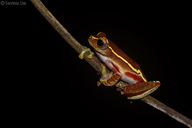|
Rhacophorus lateralis Boulenger, 1883
| family: Rhacophoridae subfamily: Rhacophorinae genus: Rhacophorus |
| Species Description: Das, I. 2000. Nomenclatural history and rediscovery of Rhacophorus lateralis Boulenger, 1883 (Amphibia: Anura: Rhacophoridae). Current Herpetology: 35-40. | |
 © 2017 Sandeep Das (1 of 9) |
|
|
|
Description Coloration: The background color of R. lateralis is green or reddish purple. Ventrally, the species is white or pinkish white. The head and back have dark dots, and colored parts of the limbs have dark cross lines. There is a white streak on each side from the nostril along the outer edge of the upper eyelid to the groin. The arm, three inner fingers, and four inner toes are clear (Boulenger 1883; Molur and Molur 2010). Distribution and Habitat Country distribution from AmphibiaWeb's database: India
Life History, Abundance, Activity, and Special Behaviors When handled, R. lateralis changes color to bright brown with coffee colored dots in only 5 seconds (Molur and Molur 2010). Trends and Threats Possible reasons for amphibian decline General habitat alteration and loss
References
Biju, S. D. (2009). ''A novel nesting behavior of a treefrog, Rhacophorus lateralis, in the Western Ghats, India.'' , 97, 433-437. Boulenger, G. A. (1883). ''Descriptions of new species of reptiles and batrachians in the British Museum.'' The Annals and Magazine of Natural History, Ser. 5, 12, 161-167. Molur, S., and Molur, P. (2010). ''Rhacophorus lateralis in Madikeri, Kodagu, Karnataka.'' http://www.zoosprint.org/ZoosPrintNewsLetter/frog_leg_14_2010may.pdf Stuart, S., Hoffmann, M., Chanson, J., Cox, N., Berridge, R., Ramani, P., Young, B. (eds) (2008). Threatened Amphibians of the World. Lynx Edicions, IUCN, and Conservation International, Barcelona, Spain; Gland, Switzerland; and Arlington, Virginia, USA. Originally submitted by: Prathik Kumar (first posted 2011-06-23) Edited by: Brent Nguyen (2012-03-22) Species Account Citation: AmphibiaWeb 2012 Rhacophorus lateralis <https://amphibiaweb.org/species/6544> University of California, Berkeley, CA, USA. Accessed Jan 1, 2025.
Feedback or comments about this page.
Citation: AmphibiaWeb. 2025. <https://amphibiaweb.org> University of California, Berkeley, CA, USA. Accessed 1 Jan 2025. AmphibiaWeb's policy on data use. |



 Map of Life
Map of Life